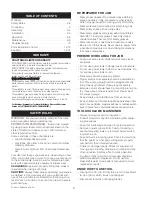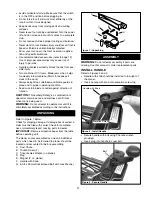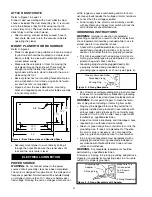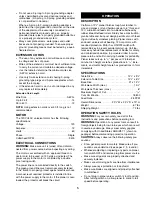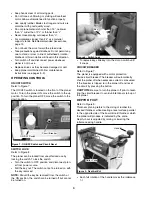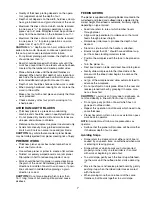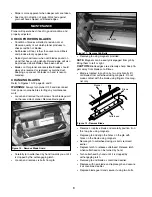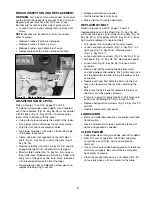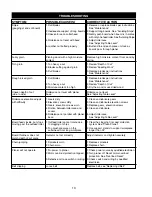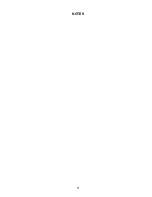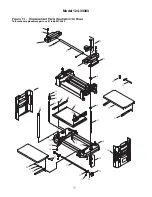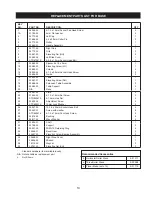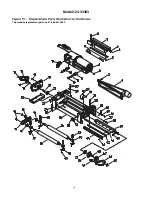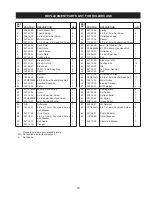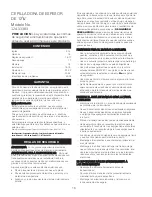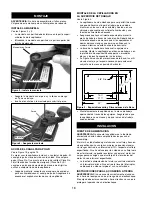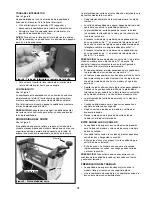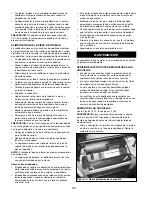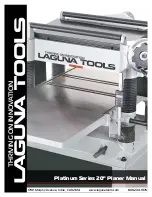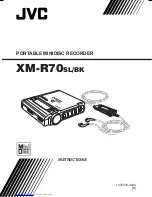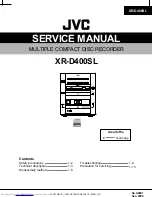
•
Quality of thickness planing depends on the opera-
tor’s judgement about the depth of cut.
•
Depth of cut depends on the width, hardness, damp-
ness, grain direction and grain structure of the wood.
•
Maximum thickness of wood which can be removed
in one pass is
3
/
32
″
for planing operations on work-
pieces up to 5
″
wide. Workpiece must be positioned
away from the center tab on the rollercase to cut
3
/
32
″
.
•
Maximum thickness of wood which can be removed
in one pass is
1
/
32
″
for planing operations on work-
piece from 5
″
up to 12
1
/
2
″
wide.
CAUTION:
A
3
/
32
″
depth-of-cut on hard, softwood 6-12
″
wide can be made. However, continuous operation at
this set-up can cause premature motor failure.
•
For optimum planing performance, the depth of cut
should be less than
1
/
16
″
.
•
Board should be planed with shallow cuts until the
work has a level side. Once a level surface has been
created, flip the lumber and create parallel sides.
•
Plane alternate sides until the desired thickness is
obtained. When half of total depth of cut is taken from
each side, the board will have a uniform moisture con-
tent and additional drying will not cause it to warp.
•
Depth of cut should be shallower when work is wider.
•
When planing hardwood, take light cuts or plane the
wood in thin widths.
•
Make a test cut with a test piece and verify the thick-
ness produced.
•
Check accuracy of test cut prior to working on fin-
ished product.
AVOID DAMAGE TO BLADES
•
Thickness planer is a precision woodworking
machine and should be used on quality lumber only.
•
Do not plane dirty boards; dirt and small stones are
abrasive and will wear out blade.
•
Remove nails and staples. Use planer to cut wood only.
•
Avoid knots. Heavily cross-grained wood makes
knots hard. Knots can come loose and jam blade.
CAUTION
: Any article that encounters planer blades
may be forcibly ejected from planer creating risk of injury.
PREPARE WORK
•
Thickness planer works best when lumber has at
least one flat surface.
•
Use surface planer or jointer to create a flat surface.
•
Twisted or severely warped boards can jam planer.
Rip lumber in half to reduce magnitude of warp.
•
Work should be fed into planer in same direction as
the grain of the wood. Sometimes grain will change
directions in middle of board. In such cases, if possi-
ble, cut board in middle before planing so grain
direction is correct.
CAUTION:
Do not plane board which is less than
14
1
/
2
″
long; force of cut could split board and cause
kickback.
FEEDING WORK
The planer is supplied with planing blades mounted in the
cutterhead and infeed and outfeed rollers adjusted to the
correct height. Planer feed is automatic; it will vary slightly
depending on type of wood.
•
Feed rate refers to rate at which lumber travels
through planer.
•
Align work perpendicular to rollercase so that work
feeds through planer straight.
•
Raise/lower rollercase to produce the depth of cut
desired.
•
Stand on side to which the handle is attached.
•
Boards longer than 24
″
should have additional sup-
port from free standing material stands.
•
Position the workpiece with the face to be planed on
top.
•
Turn the planer on.
•
Rest board end on table and direct board into planer.
•
Gently slide workpiece into the infeed side of the
planer until the infeed roller begins to advance the
workpiece.
•
Let go of the workpiece and allow automatic feed to
advance the workpiece.
•
Do not push/pull on workpiece. Move to the rear and
receive planed lumber by grasping it in same man-
ner as it was fed.
CAUTION:
To avoid risk of injury due to kickbacks, do
not stand directly in line with front or rear of planer.
•
Do not grasp any portion of board which has not
gone past out-feed roller.
•
Repeat this operation on all boards which need to be
same thickness.
•
Planer has return roller on top so assistant can pass
work back to operator.
NOTE:
Assistant must follow same precautions as
operator.
•
Surface that the planer will produce will be smoother
if shallower depth of cut is used.
Avoiding Snipe
•
Snipe refers to a depression at either end of board
caused by an uneven force on cutterhead when work
is entering or leaving planer.
•
Snipe will occur when boards are not supported
properly or when only one feed roller is in contact
with work at beginning or end of cut.
•
To avoid snipe, gently push the board up while feed-
ing the work until the outfeed roller starts advancing
it.
•
Move to the rear and receive planed board by gently
pushing it up when the infeed roller looses contact
with the board.
•
When planing more than one board of the same
thickness, butt boards together to avoid snipe.
7
Summary of Contents for 124.33383
Page 11: ...11 NOTES ...
Page 14: ... PEFM 5P QVSDIBTF SFQMBDFNFOU QBSUT DBMM ...
Page 27: ...27 NOTAS ...


